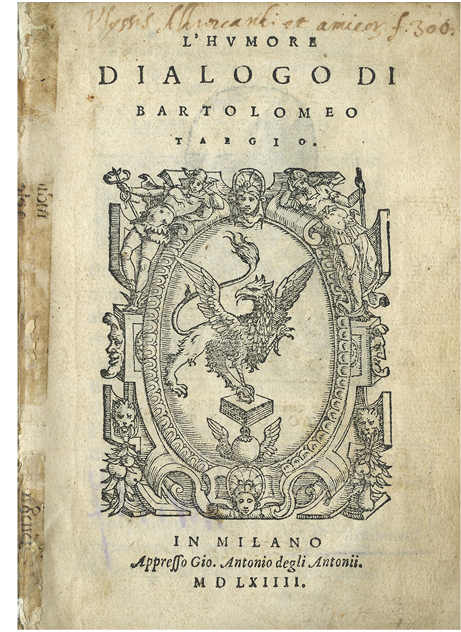
Antonella Monaco
Centro Museale Musei delle Scienze Agrarie, MUSA, Università degli Studi di Napoli Federico II
Giuseppina Chianese
Centro Museale Musei delle Scienze Agrarie, MUSA, Università degli Studi di Napoli Federico II
© Antonella Monaco, Giuseppina Chianese, 2022 /
Two handwritten notes found in a small volume published in 1564 – an older one relating to the first owner bearing the name of Ulisse Aldrovandi placed at the top of the title page, and the second one bearing the location on the tail of the book – have aroused great interest in the possibility that it could belong to the famous naturalist’s library in Bologna. A third note, placed on the doublure of front cover, refers to an unknown later owner whose identity will be sought out, based on the little information reported. Starting from these handwritten notes, the journey of the book is reconstructed in space – from Aldrovandi’s library in Bologna to the Historical Library of the Orazio Comes Botanical Museum kept at the MUSA Museum Centre in Portici – and in time – from the sixteenth to the nineteenth century.
Due note manoscritte su un volume del 1564 di Bartolomeo Taegio dal titolo L’Humore Dialogo, ora conservato nella Biblioteca storica del Museo Botanico Orazio Comes di Portici, ne attestano l’appartenenza alla Libraria di Ulisse Aldrovandi di Bologna. La prima, posta sul frontespizio, riporta la formula di possesso da lui utilizzata per i suoi volumi. La seconda nota, scritta sul bordo inferiore del libro, indica la collocazione del volume, identica a quella di una seconda copia della Libraria, riportata nel Manoscritto 147 del Fondo Aldrovandi, probabilmente alienata nel corso della ricollocazione della biblioteca nel XVIII secolo. Una terza nota manoscritta, sull’ultima pagina, si riferisce a un donatore – l’avvocato Fabio Vitali di Parma, e a un destinatario ignoto – forse Carlo Verga, avvocato e prefetto di Parma per alcuni anni. Un timbro della Biblioteca della Reale Scuola Superiore di Agricoltura di Portici indica una possibile data di acquisizione del volume precedente al 1924.
Handwritten notes; Aldrovandi; Botanical Museum.
A small volume, L’humore dialogo di Bartolomeo Taegio (In Milano, Appresso Gio. Antonio degli Antonii, 1564), now kept in the Historical Library of the Orazio Comes Botanical Museum, was found in the library of the former Institute of Arboriculture of the Department of Agriculture in Portici, at the University of Naples Federico II. It is a fine essay on vineyard cultivation and wine production by the jurist Bartolomeo Taegio.2 The booklet, consisting of eighty pages and preserved in good condition, is of particular interest because of the presence of three handwritten notes, two relating to the book’s first owner and one referring to a later owner. The first, written in cursive script, in brown ink and placed at the top of the title page, reads, Ulyssis Aldrovandi et amicor. f. 300 (Fig. 1).

Fig. 1. Handwritten ownership note by Ulisse Aldrovandi on the title page of Bartolomeo Taegio’s L’humore dialogo (1564). Copy from the Historical Library of the Orazio Comes Botanical Museum.
The name in the first note is that of the famous Italian naturalist Ulisse Aldrovandi, and it is more than a hypothesis that the volume was part of his library.3 A study which traces the history and composition of his library describes the autograph note of ownership that Aldrovandi frequently penned on the title pages of his volumes: Ulissis Aldrouandi et amicorum f., where the abbreviation/siglum f. stands for finestra (window) or ripiano (shelf), followed by a number and sometimes preceded by a capital letter.4 The expression et amicorum, so usual in his library, is still influenced by the spirit of humanism that originated in the first three decades of the fifteenth century, when renewed interest in the classical age led wealthier scholars, owners of rare Greek and Latin manuscripts, to share them with less fortunate colleagues. Because of the spreading of the printed book, the expression became very popular and widespread, losing its original meaning.5 Another research6 reports the same characteristics of Aldrovandi’s ownership notes, attributing its use to the wish to make his library available to other scholars, and it also illustrates in detail how books were positioned and distributed in the different rooms of the library. The library specifically consisted of three rooms called Prima libraria (First library), Seconda libraria (Second library) and Camera bura (Darkroom). The first two were furnished with wooden cabinets, marked with numbers ranging from 1 to 193 and from 194 to 281 respectively. The cabinets contained caselle (boxes) or finestre (shelves) of various sizes, marked with numbers ranging from 1 to 600. The “Darkroom” contained three cabinets dedicated to books of different sizes, labelled with letters, from A to D.
In Taegio’s book, the annotation f. 300 on the title page thus indicates the “window”, for “shelf”, where the volume was placed in the library. The practice of noting author, title, and position on the tail of books was also typical of the arrangement used by Aldrovandi. Because of the limited space, the books were piled flat on the shelves rather than standing with their spine facing outward. These brief and essential information on books were very helpful to identify them easily,7 just as the second handwritten note on our copy, which was penned in brown ink block letters on the tail, indicates, “Bart’s humor. Tegio 250”, with an obvious error in the author’s name and a number indicating the position of the book (Fig. 2A). This spelling of the author’s surname – Tegio instead of Taegio – is probably due to an incorrect transcription of the diphthong ae of the surname, which was read as a Latin name instead of an Italian one. A further inaccuracy is present on the smooth spine label: Targio instead of Taegio, perhaps because the letter of the author’s surname, given on the title page, was confused with the letter “r” (Fig. 2B).

Fig. 2A. The tail of the book with title, author, and signature/position in Aldrovandi’s Library. Copy from the Historical Library of the Orazio Comes Botanical Museum.

Fig. 2B. Leather gusset on the spine. Copy from the Historical Library of the Orazio Comes Botanical Museum.
The codicological argument also confirms that this book belonged to Aldrovandi’s library. The binding of the volumes in Aldrovandi’s library is in fact so peculiar that they can be distinguished from other bindings of the same period: it is usually characterized by a very basic structure, in floppy parchment, with or without laces, protruding lips and covers sometimes lined with sheets of ancient codices on which traces of writing or musical composition can be detected. Original bindings could sometimes come from volumes purchased from second-hand book sellers already provided with covers or from private gifts.8 As for the binding of this copy of Taegio’s book, on the other hand, some features, such as the full vellum cover on stiff cardboard plates with through-ribbed nerves (Fig. 3), the brown leather gilt-framed gusset with the name of the author and part of the title stamped in gold pasted on the smooth spine (a widespread use from the seventeenth century onward)9 and the ivory and light blue sewing threads, different from those used for Aldrovandi’s volumes (usually ivory and orange) suggest a later restoration, made between the seventeenth and eighteenth centuries. Other physical elements, such as a paper strip from an ancient codex pasted on the title page in restoration of the hinge (Fig. 4), or the inscription on the tail, confirm the hypothesis that the book belongs to Aldrovandi’s library. The strip of paper used in the binding of the volume belongs to the category of the so-called “hidden texts”, namely manuscript or print fragments that were discarded and then reused in subsequent bindings. This practice of discarding and reusing fragments had a considerable development after the invention of printing and the increase in book production. Bookbinders used this material mainly in armatures, as reinforcements and lining of plates and covers.10
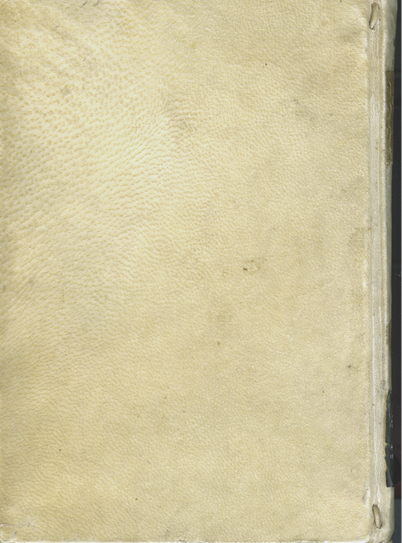
Fig. 3. Hard vellum cover. Copy from the Historical Library of the Orazio Comes Botanical Museum.
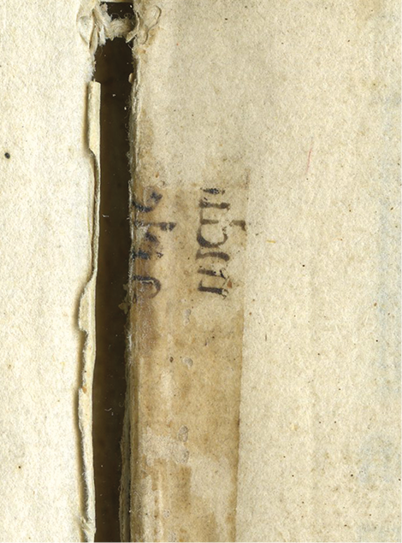
Fig. 4. Strip of paper from an ancient codex to reinforce the hinge. Copy from the historical library of the Orazio Comes Botanical Museum.
Other documents in Aldrovandi’s collection place Taegio’s work in the very same hands. The list of books reported in MS No. 147 of the University Library of Bologna mentions two copies of the Taegio’s volume in the naturalist’s library, one of which bears the same shelf number present on the tail of our copy (Fig. 5).11 It is possible that the copy kept in Comes’ library may be one of the two copies alienated as doubles between the eighteenth and nineteenth centuries, when Aldrovandi’s library – which had been closed in boxes for ten years as a result of its move from the halls of the Senate to the Institute of the Sciences in Bologna – was finally reordered and catalogued in 1755.12 A comparison between our copy and those preserved at the University Library of Bologna (Fig. 6), confirms its origin beyond any possible doubt.

Fig. 5. Page of MS. 147 of the Aldrovandi collection, University Library of Bologna.
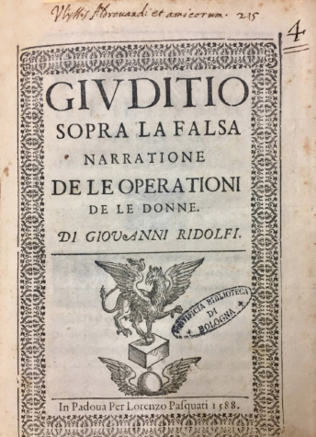
Fig. 6. Handwritten ownership note on the title page of another volume (Giovanni Ridolfi, Giuditio sopra la falsa narration de le operationi de le donne, Padova 1588) in the Aldrovandi collection, University Library of Bologna.
The presence of a work by a jurist such as Bartolomeo Taegio in Ulisse Aldrovandi’s library is not surprising, since, as Ventura Folli’s study quoted earlier reports: “[…] The ‘libraria’ thus represents the indispensable starting point for any future investigation, a system of information interchange in a circular vision of knowledge. […] The classification proposed by Aldrovandi is divided into the following classes: grammar / logic / rhetoric / poetics / historici / chronologia / aritmetica / mechanice / dell’altre arti / de arte metallica / arte fusorum / cosmographia / musica / astrologia / in philosophia morale / economica / politica / philosophia naturalis / historia plantarum / historia animalium / historia fossilium / medicina teorica e prattica / arte destillatoria / agricoltura / iurisprudentia / arte culinaria / metaphysica / theologia.”13 As illustrated by this list, the scholar’s interests included not only the natural sciences but also subjects as far apart as philosophy and the cooking arts. It is possible that Ulisse Aldrovandi, driven by a desire for knowledge in all its forms and with a background in law studies and a charge of heresy by the Inquisition Tribunal – events similar to those experienced by Bartolomeo Taegio – was intrigued by a technical work in literary form on the subject of agriculture, like Taegio’s book. Moreover, this book found a great success after its publication and probably circulated in a large number of copies, many of which can still be found today in many Italian libraries.
The third handwritten note tells of the book’s journey through space and time: from Ulisse Aldrovandi’s library in Bologna to the private libraries first of the lawyer Fabio Vitali (see above) and then of a yet unknown receiver, from the sixteenth to the twentieth century, when it finally arrives to the R. Scuola Superiore di Agricoltura in Portici (Royal High School of Agriculture in Portici). Written in a cursive script on the back of front cover page, the note says, Dono dell’egregio e Carissimo collega avvocato Fabio Vitali (Gift of the egregious and dearest Colleague attorney Fabio Vitali) (Fig. 7). Three features suggest that this note was written long time after the book was published: the sentence structure and terms used (certainly not in use in the sixteenth century), the handwriting (very small in size), and the writing instruments (black ink and very fine-pointed pen). The note indicates the existence of a receiver and a donor. The latter corresponds, most likely, to the lawyer Fabio Vitali (Parma, 1813–1892), a descendant of a well-known family of jurists and men of letters from Parma, and custodian, together with his brother Patroclus, of an important archive of manuscript codices and of a library consisting of about 14,000 volumes,14 now partly preserved it the Biblioteca Comunale Passerini-Landi in Piacenza.15 The identity of the receiver is not explicitly stated. However, on the basis of a number of clues embedded in the note, it is possible to tentatively identify him with the Senator Carlo Verga, also a law graduate, who lived in Parma, where he served as Prefect from June 22, 1862, to February 24, 1869.

Fig. 7. Third handwritten note of ownership on the doublure of the front cover. Copy from the Historical Library of the Orazio Comes Botanical Museum.
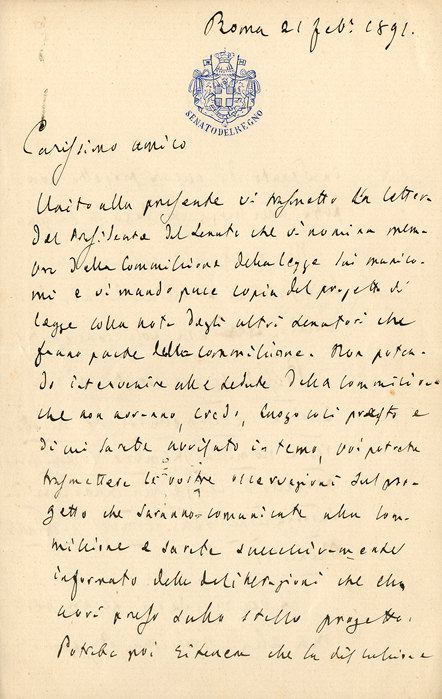
Fig. 8. Handwritten letter by Carlo Verga dated February 21, 1891 (Coyright Municipality of Milan, Palazzo Moriggia, Museo del Risorgimento).
First of all, the expression egregio e carissimo Collega, suggests that both practiced law and had a personal relationships (the adjective carissimo expresses, in fact, a strong feeling of fondness and respect), since they likely lived in the same city, Parma. Secondly, the city of Novara represents a local connection between Vitali, Verga, and the setting of Taegio’s work. The subject of the essay is, in fact, the large vineyard estate that Taegio owned in Novara, where he lived for several years. Carlo Verga, on his part, was born in 1814 in Vercelli, a province joined to that of Novara after the Villafranca armistice.16 In the context of a gift exchanged between two bibliophile friends, it is not farfetched to imagine that the element of local history played a role. Moreover, some features of Prefect Carlo Verga’s handwriting (Fig. 8)17 match the hand of the receiver of the gift – such as the shape of the double s, and of the letters r, d, v, b – corroborating the hypothesis with a solid palaeographic argument.
As for the present location of the book, it is not possible to determine exactly how, by gift or purchase, and when Taegio’s volume was acquired by the Portici library for lack of inventory records witnessing to the date of its acquisition. The loss of the library’s documents probably occurred in 1943, during the military occupation by the Allied troops of the Royal Palace of Portici, which housed the Faculty of Agriculture of the University of Naples. It lasted a whole year and caused considerable damages to both the building and the equipment. Even entire collections of rare plants in the adjoining Botanical Garden were destroyed by the passage of heavy vehicles so many furnishings, including books from the library, were damaged or stolen. On 12 September of the same year, a fire caused by German troops destroyed the historic building of the university in the centre of Naples, which housed all administrative documentation including that of the library purchases.18 The presence, on the back of the title page, of a square purple ink stamp with the heading R. Scuola Superiore di Agricoltura in Portici and an inventory number 16581 (Fig. 9) narrows down the possible date of its purchase by the main library of the Royal School to a period before 1924, when the Scuole Superiori di Agricoltura Italiane (Italian Schools of Agriculture) were transferred from the Ministry of Agriculture, Industry, and Commerce (MAIC) to the Ministry of National Economy under the name R. Istituti Superiori Agrari (Royal Agricultural Colleges).19 As a result, the main library of Royal School was reorganized, the books were then relocated with a new inventory number and the “Orazio Comes” Library, which had transferred there after his death in 1917, was divided according to the different scientific subjects he had dealt with. Each group thus obtained was given to the libraries of the Institutes of Arboricoltura, Botany, Entomology, Phytopathology of the Royal School.20 Taegio’s book was transferred to the library of Arboriculture with a new inventory and position number where it remained until 2011, when the ancient collections of many libraries of the former institutes of the Faculty of Agriculture were transferred to the Historical Library of the Orazio Comes Botanical Museum of the Museum Center of Agricultural Sciences Museums - MUSA of the University of Naples Federico II.21 During the placement of the ancient volumes at the new location, a more exhaustive review was carried out showing the handwritten notes on Taegio’s book that had not yet been observed and appreciated for their historical importance.22
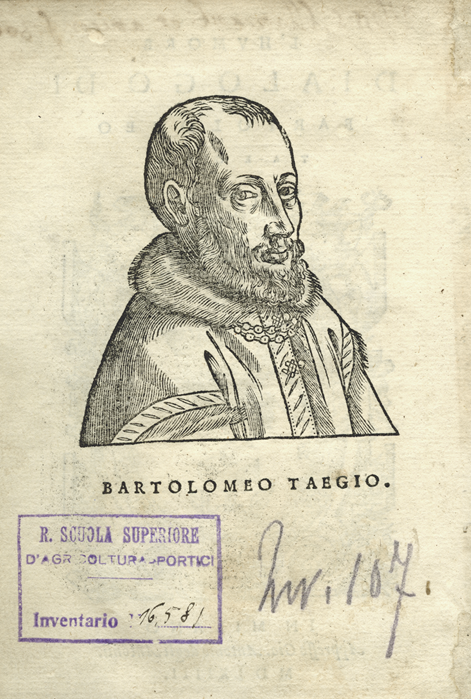
Fig. 9. Stamp and inventory of the library of the Royal School of Agriculture in Portici under the portrait of Taegio.
1 The authors would like to thank Giovanna Flamma of the University Library of Bologna and Massimo Baucia of the Passerini-Landi Library of Piacenza for their valuable cooperation in making the documents needed for their work available.
2 Fabrizio Govi, I classici che hanno fatto l’Italia: per un nuovo canone bio-bibliografico degli autori italiani (Modena: Regnani, 2010), 107. The biographical notes report that Bartolomeo Taegio (ca. 1520–1573) was a jurist and man of letters in Milan. On a murder charge, he had to flee to Novara, where he settled and made a living practicing law. There he also founded a semi-clandestine literary association called Accademia dei Pastori dell’Agogna (Academy of the Shepherds of the Agogna) in 1550. A few years later, he had to leave Novara because he was reported to the Inquisition Tribunal and returned to Milan, where he was later appointed governor of the Lake Orta County and attended the Collegio dei Giureconsulti. His interest in pastoral and arcadian life is expressed in two of his works. The first one is La Villa (1559), in which the country life of the noble class of Milan is described; while the second one is entitled L’humore dialogo (1564), an essay on all aspects related of the vineyard, the production and storage of various types of wine and their effect on health, written in the form of a conversation with his friend Giovanni Paolo Barza. Although written in a narrative and literary style, it shows a solid knowledge of agriculture by the author, who owned a farmland in Novara (Italy), of which he personally took care. For a more extensive biography of Taegio, see also Notizie biografiche raccolte dall’avv. Giovanni Battista Finazzi, ad illustrazione della bibliografia novarese (Novara: Tipografia Novarese di Rizzotti e Merati, 1890), 132–135.
3 An extensive and comprehensive bibliography on Ulisse Aldrovandi can be found in https://bub.unibo.it/it-it/bublife/maggio-2006/bibliografie-tematiche/per-una-bibliografia-su-ulisse-aldrovandic7b6.html?idC=61727&LN=it-IT (accessed 13th April 2021).
4 Irene Ventura Folli, “La Natura Scritta: La ‘Libraria’ di Ulisse Aldrovandi (1522-1605),” in Bibliothecae selectae: da Cusano a Leopardi, ed. Eugenio Canone (Firenze, L.S. Olschki, 1993), 495–501; see also Caroline Duroselle-Melish and David Lines, “The Library of Ulisse Aldrovandi (†1605): Acquiring and Organizing Books in Sixteenth-Century Bologna,” The Library 16, 2 (2015): 133–161.
5 Geoffrey D. Hobson, “Et amicorum,” The Library, Fifth series, IV, n. 2 (September 1949): 95.
6 Maria Cristina Bacchi, “Ulisse Aldrovandi e i suoi libri,” L’Archiginnasio C (2005): 255–366.
7 Ibid., 268.
8 Ibid., 281–284.
9 Comparison of ligature type was made on the basis of descriptions obtained from “Fondi Antichi, guida alla catalogazione: legature (glossario),” Università di Modena e Reggio Emilia- CSBA, http://www.fondiantichi.unimo.it/fa/guida2/legature.html (accessed 28th April 2021); see also Federico Macchi, Considerazioni generali sulle legature dei secoli XV-XX in http://legacy.bibliotecamai.org/cataloghi_inventari/legature_storiche/considerazioni_generali_legature.html (accessed 20th October 2022).
10 Cristina Cicero, Fulvio Mercuri, Noemi Orazi, Ugo Zammit, Stefano Paoloni, and Massimo Marinelli, “Testi nascosti nelle legature librarie: individuazione e lettura tramite la termografia infrarossa,” in Griechisch-byzantinische Handschriftenforschung: Traditionen, Entwicklungen, neue Wege, ed. Christian Brockmann, Daniel Deckers, Dieter Harlfinger and Stefano Valente (Berlin, Boston: De Gruyter, 2020), 537–548, https://doi.org/10.1515/9783110366358-040 (accessed 20th October 2022).
11 Biblioteca Universitaria di Bologna, Manoscritto 147, Fondo Aldrovandi.
12 Bacchi, “Ulisse Aldrovandi e i suoi libri,” 262.
13 Ventura Folli, “La Natura Scritta,” 496.
14 Michelangelo Ferraro (ed.), Archivio Vitali-Verga, Soprintendenza Archivistica per l’Emilia-Romagna, Direzione generale per gli Archivi, 2009. The Vitali-Verga archive was acquired in 2010 by the Direzione generale per gli Archivi tramite la Soprintendenza Archivistica per l’Emilia-Romagna and is preserved in the Parma Archives. At that time, the author drafted a detailed list of archival documents, introduced by a retrospective reconstruction of their purchase http://www.sa-ero.archivi.beniculturali.it/fileadmin/template/allegati/pubblicazioni/interventi/Vitali-Verga_ferraro.pdf (accessed 23rd March 2021).
15 Biblioteca comunale Passerini Landi del Comune di Piacenza, Fondo Antico.
16 Biographical notes on Carlo Verga were taken from https://notes9.senato.it/web/senregno.nsf (accessed 10th May 2021).
17 Image provided by the Archivio Andrea Verga, Palazzo Moriggia – Museo del Risorgimento, Milano.
18 Alessandro Santini, “Dal secondo dopoguerra agli inizi degli anni settanta,” in La Scuola Agraria di Portici e la modernizzazione dell’agricoltura 1872-2012 (Napoli: Image, 2015), 169–170, 180, 332.
19 Since 1872, the year of its founding, the Royal High School of Agriculture in Portici was provided with a main library and secondary libraries to support the various teaching subjects; see Maria Laura Castellano, Antonella Monaco, “Storia della Biblioteca e del patrimonio librario della Scuola superiore di Agricoltura,” La Scuola Agraria di Portici e la modernizzazione dell’agricoltura 1872-2012 (Napoli: Image, 2015), 307–333, https://www.centromusa.it/pubblicazioni/ScuolaAgraria.pdf.
20 Orazio Comes (1848–1917) was one of the most important botanists from Southern Italy and one of the first teachers at the Royal School of Agriculture in Portici, where he worked for forty-three years. There he devoted himself to teaching, researching and directing the Botanical Garden, which he enriched with several collections of rare plants. His scientific interest was also in other subjects such as arboriculture, agronomy, entomology, and phytopathology. As a scientist he collected 1757 monographs, journals and pamphlets related to the scientific fields mentioned above. For an exhaustive biography of Orazio Comes, see Maurizia Alippi Cappelletti, in Dizionario Biografico degli Italiani (Roma: Istituto dell’Enciclopedia Italiana, 1981), vol. 27, s.v.; available also at https://www.treccani.it/enciclopedia/orazio-comes_(Dizionario-Biografico)/ (accessed 20th October 2022).
21 In 1957, The Botanical Museum was dedicated to Orazio Comes to celebrate the fiftieth anniversary of his death; see Valeria Mezzetti Bambacioni, “In ricordo di Orazio Comes nel cinquantenario della sua morte,” Annali della Facoltà di Scienze Agrarie dell’Università di Napoli, in Portici, s. IV, vol. II, 1967.
22 A more detailed description of the history and structure of the Historical Libraries of the Museum Center Museums of Agricultural Sciences can be found in Antonella Monaco, Giuseppina Chianese, “Le Biblioteche storiche del MUSA”, https://www.centromusa.it/it/biblioteca-storica.html (accessed 8th November 2022).